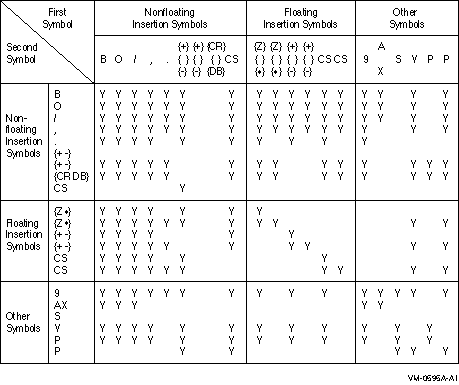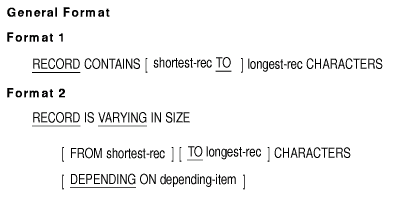 |
HP COBOL
Reference Manual
Zero Suppression and Replacement Editing
- One or more occurrences of the space symbol (Z) or the asterisk
(*) define a floating suppression string, which can suppress leading
zeros in numeric character positions. The space symbol (Z) causes
spaces to replace the zeros; an asterisk (*) causes asterisks to
replace the zeros.
The suppression symbols are mutually exclusive.
That is, character-string can contain either the space symbol
(Z) or the asterisk (*), but not both.
Each suppression symbol
counts toward the size of the item.
You can include simple
insertion symbols either within the floating string or immediately to
its right. These simple insertion symbols are treated as part of the
floating string. That is, they appear in results only when the value of
the item is large enough to include a position occupied by a simple
insertion symbol.
You can use zero suppression symbols to represent
either:
- Any or all leading numeric character positions to the left of the
decimal point
- All numeric character positions on both sides of the decimal point
For example, both ZZZ9.99 and ZZ.ZZ are valid
character-strings, but ZZZ.Z9 is not.
The following actions occur if the suppression symbols represent
any or all leading numeric character positions to the left of the
decimal point:
- The replacement character replaces any leading zero in the data
that corresponds to a suppression symbol in the string.
- Suppression ends at either the first nonzero digit in the data
represented by the suppression string or at the decimal point,
whichever appears first in the data.
The following events occur if the suppression symbols represent all
numeric positions in character-string:
- If the value of the data is not zero, the result is the same as if
all suppression symbols were to the left of the decimal point. That is,
zeros to the right of the decimal point are not suppressed.
- If the value is zero and the suppression symbol is a Z, all
character positions in the edited item (including any editing
characters) contain spaces.
- If the value is zero and the suppression symbol is an asterisk (*),
all character positions in the edited item (including any insertion
editing characters other than the decimal point) contain asterisks. The
decimal point appears in the item.
- The plus sign (+), minus sign (-), asterisk (*), space (Z), and
currency symbol (cs) are mutually exclusive when they are used as
floating replacement characters. That is, if any one of these symbols
appears as a floating replacement character, none of the other symbols
can appear as a floating replacement character in the same PICTURE
clause.
PICTURE Symbol Precedence Rules
- character-string must contain either:
- At least one of the symbols A, X, Z, 9, or asterisk (*)
- At least two of the symbols plus sign (+), minus sign (-), or
currency symbol (cs)
- Figure 5-10 summarizes the rules for combining symbols to form
character-strings more complex than the basic possibilities
listed in rule 1. The table shows that the use of one symbol in a
character-string excludes the use of certain others before or
after it.
The table uses the following conventions:
- A Y at an intersection means the symbols at the top of the
column (First Symbol) can precede the symbols at the left of
the row (Second Symbol).
- Braces ({ }) enclose symbols that are mutually exclusive.
- The currency symbol appears as cs.
- Symbols appear twice in a column or row when their rules of use
depend upon their location in a character-string. These double
entry symbols are as follows:
- Fixed insertion symbols (+ and --)
- Floating symbols Z, asterisk (*), plus sign (+), minus sign (-),
and currency symbol (cs)
- P
The uppermost entry in a column (or the leftmost entry in a row)
represents symbol use left of the actual or implied decimal point
position. The second entry represents symbol use to the right of the
decimal point.
Figure 5-10 PICTURE Symbol Precedence Rules

Additional References
Examples
The Procedure Division entry for the MOVE statement contains examples
that illustrate this clause.
Function
The RECORD clause specifies the number of character positions in either
a fixed- or variable-length record. If the number of character
positions does not vary, the RECORD clause specifies the minimum and
maximum number of character positions in a variable-length record.

shortest-rec
is an integer that specifies the minimum number of character positions
in a variable-length record. Its value must be greater than or equal to
zero.
longest-rec
is an integer greater than shortest-rec. It specifies the
maximum number of character positions in a variable-length record or
the size of a fixed-length record.
depending-item
is the data-name of an elementary unsigned integer data item in the
Working-Storage or Linkage Section. It specifies the number of
character positions for an output operation, and it contains the number
of character positions after a successful input operation.
Syntax Rules
- No record description entry for a file can specify the following:
- Fewer character positions than shortest-rec
- More character positions than longest-rec
- In a sort-merge file description entry, the first
shortest-rec character positions of the record must be large
enough to include all keys specified in any SORT or MERGE statement for
the sort or merge file.
- For an indexed file, the first shortest-rec character
positions of the record must be large enough to include all record keys.
- If the DEPENDING ON phrase is present and if the associated file
connector is an external file connector, depending-item must
have the external attribute and must specify the same data-name in all
file description entries associated with the external file connector.
General Rules
Both Formats
- The absence of a RECORD clause is the same as a Format 1 RECORD
clause with no shortest-rec phrase and with
longest-rec equal to the greatest number of character
positions described for any of the file's records.
- The number of characters described by a record description entry is
the sum of both of the following:
- The number of character positions in all elementary items excluding
redefinitions and renamings
- The number of fill bytes added because of alignment requirements
If the record description entry contains a table definition, the
sum includes the number of character positions in the maximum number of
table elements.
- If the associated file connector is an external file connector, all
file description entries in the run unit associated with that file
connector must define the same values for shortest-rec and
longest-rec. If the RECORD clause is not specified, all record
description entries associated with this file connector must be the
same length.
Format 1
- If there is no shortest-rec phrase, Format 1 specifies
fixed-length records. longest-rec then specifies the number of
character positions in each record of the file.
- If there is a shortest-rec phrase, Format 1 specifies
variable-length records, the same as Format 2 without the DEPENDING
phrase.
- For variable-length records:
- The maximum record size for a READ or RETURN operation is the
number of character positions described in the largest record
description entry for the file.
- During execution of a RELEASE, REWRITE, or WRITE statement, the
number of character positions in a record equals the number of
character positions in the record description entry referred to by the
statement.
- If all record description entries for the file describe records of
the same size, RELEASE, REWRITE, and WRITE statements for the file
transfer fixed-length records in variable-length format.
Format 2
- Format 2 specifies variable-length records.
- If the clause does not contain shortest-rec, the minimum
number of character positions in any of the file's records is the least
number of character positions described by a record description entry
for the file.
- If the clause does not contain longest-rec, the maximum
number of character positions in any of the file's records is the
greatest number of character positions described by a record
description entry for the file.
- If there is a DEPENDING phrase, the program must set
depending-item to the number of character positions in the
record before executing a RELEASE, REWRITE, or WRITE statement for the
file.
- After successful execution of a READ or RETURN statement for the
file, the value of depending-item indicates the number of
character positions in the accessed record.
- The depending-item value is not changed by executions of:
- DELETE and START statements
- Unsuccessful READ and RETURN statements
- For RELEASE, REWRITE, and WRITE statement execution, determining
the number of character positions in the record depends partly upon
whether or not the record contains a variable occurrence item (an item
described by the OCCURS clause or one that is subordinate to another
item so described). During execution of these statements, three rules
determine the number of character positions in the record:
- If there is a depending-item, its value specifies the
number of character positions.
- If there is no depending-item and the record does not
contain a variable occurrence item, the number of character positions
described by the record description entry specifies the number of
character positions.
- If there is no depending-item and the record contains a
variable occurrence item, the number of character positions is the sum
of the character positions in the fixed part of the record and the
table elements specified by the OCCURS clause depending-item
when the output statement executes.
|

